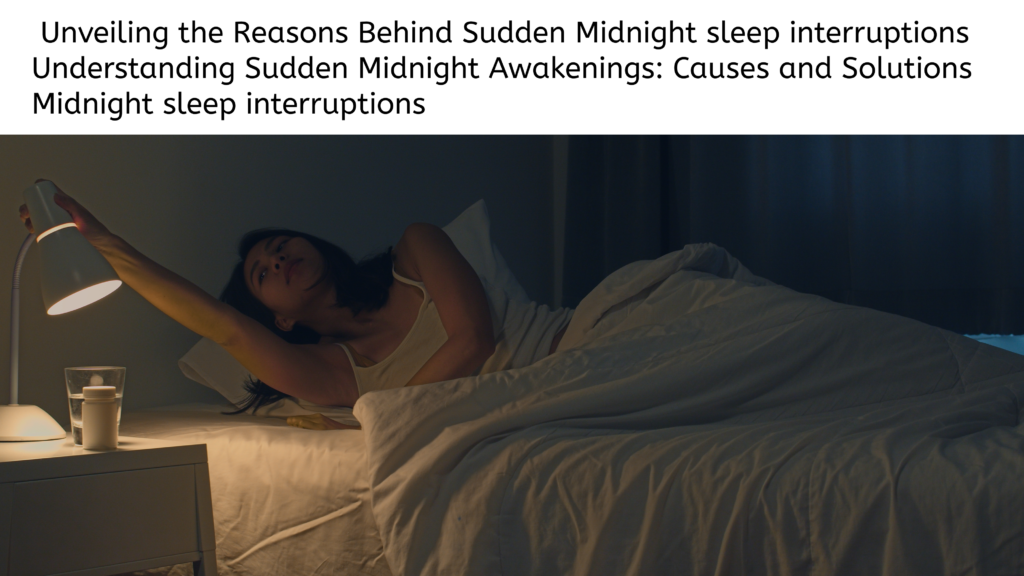Understanding Sudden Midnight Awakenings: Causes and Solutions
Midnight sleep interruptions:
Midnight awakenings, often an unsettling occurrence, disrupt our sleep patterns and leave us seeking answers. At their core, these abrupt interruptions in our slumber may stem from various factors, ranging from external stimuli to underlying health conditions. Understanding these causes and exploring viable solutions is crucial to reclaiming restful nights.
Uncovering the Causes
1. Environmental Factors
Our immediate surroundings play a pivotal role in disrupting sleep. Factors such as excessive noise, uncomfortable room temperature, or intrusive light sources can jolt us awake. Addressing these elements by employing white noise machines, adjusting room temperature, or using blackout curtains can mitigate their impact.
2. Stress and Anxiety
Mental health can significantly influence our sleep patterns. Stress and anxiety often manifest during the night, causing sudden awakenings. Techniques like mindfulness meditation, relaxation exercises, or seeking professional guidance can aid in managing these issues.
3. Sleep Disorders
Underlying sleep disorders like sleep apnea or restless leg syndrome can prompt midnight awakenings. Seeking a healthcare professional for a comprehensive evaluation and potential treatment options is crucial to tackling these conditions effectively.
4. Medication Effects
Certain medications may have side effects that disrupt sleep cycles, leading to sudden awakenings. Consulting a physician to explore alternative medications or adjusting dosage timings can alleviate this issue.
Solutions for a Restful Night’s Sleep
1. Establishing a Sleep Routine
Consistency is key. Creating a nightly ritual that includes calming activities before bedtime signals to the body that it’s time to unwind, fostering better sleep.
2. Optimizing Sleep Environment
Crafting a sleep-conducive environment involves controlling external factors like light, noise, and temperature. Additionally, investing in a comfortable mattress and pillows can vastly improve sleep quality.
3. Stress Management Techniques
Incorporating stress-relief practices into daily life, such as yoga, deep breathing exercises, or journaling, can significantly reduce the likelihood of midnight awakenings due to stress or anxiety.
4. Seeking Professional Help
For persistent sleep disturbances, seeking guidance from a sleep specialist or healthcare professional can lead to tailored solutions, whether through therapy, medication, or lifestyle adjustments.
The frequent awakenings at 12 AM and 3 AM what’s causing them?
Why Do I Wake Up at Midnight and 3 AM?
Waking up in the middle of the night is quite common. Sometimes, we wake up briefly without realizing it and go back to sleep quickly. But if you find yourself wide awake at 3 AM, there could be a few reasons for it.
Sleep Cycles and Night Waking
During the night, our sleep consists of different cycles. It’s normal to wake up a few times during these cycles and go back to sleep without noticing.
Reasons for 3 AM Wake-Ups
Several things might cause you to wake up at 3 AM:
- Stress: Feeling stressed can make you wake up suddenly. It triggers your body, making it hard to fall back asleep.
- Insomnia: This is when you regularly struggle to fall back asleep after waking up at night. Lots of people experience this.
- Aging: As we get older, our sleep changes. We might take medications or develop conditions that affect sleep quality.
- Medications: Some medications can disrupt sleep patterns.
- Health Conditions: Conditions like sleep apnea, GERD, arthritis, or menopausal symptoms might cause you to wake up.
Lifestyle Habits and Sleep Quality
How you live can affect your sleep:
- Screens before Bed: Looking at screens late at night can disrupt sleep.
- Diet and Habits: Eating certain foods, drinking alcohol or caffeine, or not getting enough exercise can impact sleep.
Improving Sleep
To sleep better:
- Consistent Bedtime: Try to sleep and wake up at the same time every day.
- Sleep Environment: Make your sleep space comfortable, dark, and quiet.
- Relaxation Routine: Have a calming routine before bed, like reading or meditating.
- Limit Screen Time: Avoid screens before sleep.
When to Seek Help
If these wake-ups affect your daily life or happen often, it’s essential to talk to your doctor. They can suggest changes or treatments to help improve your sleep.
Does waking up at 2 am mean someone is watching you?
Waking up at 2 AM doesn’t imply someone’s watching you it’s a myth lacking scientific or logical support. Often, people wake at different night hours due to stress, anxiety, or shifts in sleep routines. If sleep troubles persist, enhancing sleep habits and consulting a professional can be beneficial.
If a deceased person communicates with you in a dream, it might signify an important message they wish to convey. It could hold expressions of affection or serve as a cautionary note about forthcoming events. It’s crucial to heed their words as they could profoundly influence your life.

